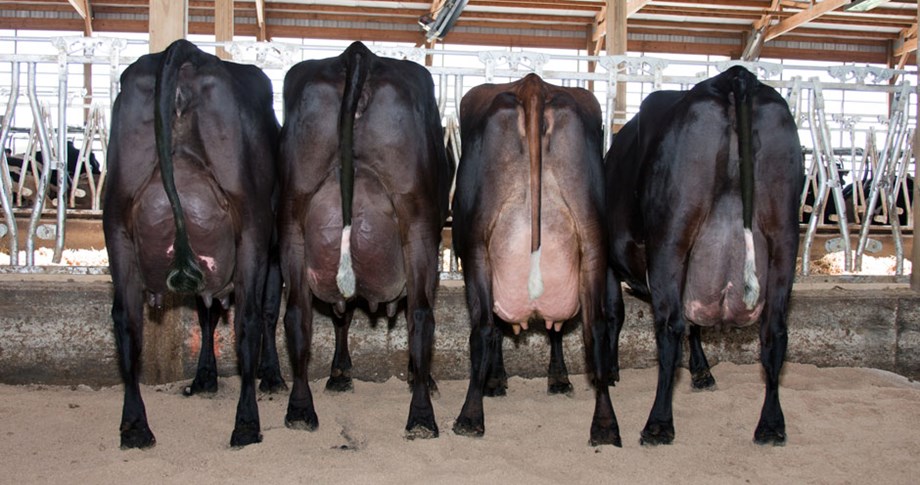Groups of Norwegian Red (NRF) crosses were established in cooperating dairy herds by using NRF sires on Holstein or Holstein-based crossbred cows.
Cows included in the study calved from January 2005 to 2011 including 42,012 1st lactation cows (914 NRF daughters) from 36 herds and 22,947 2nd lactation cows (344 NRF daughters) from 31 herds.
Milk yield, fat yield, protein yield and somatic cell score
Purebred Holsteins produced significantly (P<.01) more milk, fat and protein compared with the NRF-sired crosses in 1st and 2nd lactation. The mature equivalent (ME) 305-day milk, fat and protein yields of Holsteins in 1st lactation were 11,657 kg, 442 kg and 354 kg, respectively, versus 11,147 kg, 430 kg and 345 kg for 1st lactation NRF-sired crosses. Second lactation ME 305-day milk, fat and protein yields for Holsteins were 11,224 kg, 429 kg and 345 kg, respectively, versus 10,360 kg, 402 kg and 325 kg for NRF-sired crosses.
Differences in yields between Holsteins and NRF-sired crosses were numerically higher in second lactation than in first lactation which could reflect heavier culling in the Holsteins; NRF crosses had a significantly better survival rate to 2nd lactation compared with Holsteins, 84.2% versus 76.9% (survival rates were calculated from cows that calved early enough in the project to have the opportunity for a second lactation).
Differences in production traits between Holsteins and NRF-sired crosses (510 kg milk, 12 kg fat, and 9 kg protein in 1st lactation) were similar to what was expected based on current USDA/Interbull genetic evaluations for the Holstein and NRF sires included in the study.
Holsteins and NRF crosses did not differ significantly in lactation average somatic cell scores (SCS) in 1st or 2nd lactation. Differences in clinical mastitis incidence or intramammary infection rates could exist and not be detected by using SCS as in this study. In addition, there was no indication that NRF crosses were relatively better for yield traits or SCS compared to Holsteins in heat stress environments.
Fertility traits
The NRF-sired crosses were clearly superior to Holsteins for conception rate at first service and days open. Conception rates were significantly higher (P<.01) in 1st lactation and 2nd lactation for NRF-sired crosses. First lactation conception rates were 37% for NRF-sired crosses and 30% for Holsteins; 2nd lactation conception rates were 37% for NRF crosses and 24% for Holsteins.
Days open was 10 days shorter in 1st lactation cows and 17 days shorter in 2nd lactation cows for NRF-sired crosses versus Holsteins.
Many of the herds used heat synchronization programs and this may have had more of a positive impact on days open in Holsteins compared with NRF crosses. Current USDA/Interbull genetic evaluations for sires represented in the study suggest that NRF-sired crosses would be expected to be about 10% higher in conception rate compared with Holsteins.
Summary
Norwegian Red crossbreds compared favorably with pure Holsteins under intense management in large herds in the USA.
Norwegian Red crosses were dramatically better for reproduction than Holsteins. Holsteins produced more milk volume than the NRF crosses but the advantage of Holsteins for fat and protein yields were small in this study.
The advantage of the NRF crosses for days open would likely negate any small differences in fat and protein yields favoring Holsteins in this study. The NRF crosses are smaller than the USA Holsteins so the fat and protein yields relative to body weight likely favor the NRF crosses.
Funding Agency
Norwegian Research Council funded Project 193604/I10, Improving Health and Fertility in US Holsteins by Crossing with Norwegian Red.
Authors
Dr. Gary Rogers, Geno Global technical advisor, and Joan Cooper, Geno Global data analyst. This report is an excerpt from a February 2012 report to The Research Council of Norway.
Collaborators
University of Wisconsin-Madison: Dr. Kent Weigel and Suzanna L. Grooms, M.S. – Suzanna's 2012 M.S. thesis is entitled "The Effects of Crossbreeding on Fitness and Production Traits in Dairy Cattle, with Emphasis on Norwegian Red Crosses."
Early Project Coordinators
Dr. E.B. Burnside, Professor Emeritus at the University of Guelph and Dr. Torstein Steine, Head of Department of Animal and Aquacultural Sciences at the Norwegian University of Life Sciences.
